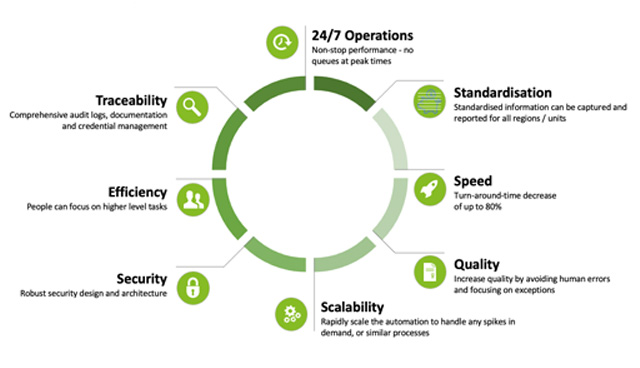Intelligent automation: Enabling your operations

Digital transformation can help enhance our public services by improving back office operations to better serve the needs of citizens, businesses, and employees through the innovative use of design, operations and new technology, write Shane Mohan and Louise McEntee of Deloitte.
Robotic Process Automation (RPA) is a practical and pragmatic approach to move towards digital transformation that is within reach for all organisations and business areas. Our experience with a range of public bodies is that they can implement automations that deliver material efficiencies, time and cost savings in a very short time – a few months, and even weeks in some cases.
RPA is here to stay
In the past few years, we have seen organisations embrace digital ways of working, and many have incorporated robotic process automation as part of their transformation journey, to support their people and enable their operational efficiency.
We are working with organisations across the public sector to:
- Help them to imagine the possibility intelligent automation presents for their organisation;
- Deliver their vision for automation and release immediate value from basic RPA through to intelligent automation;
- Transform their operations by exploring how they can redesign their service model and operations to really get the best from both people and their digital workforce; and
- Build new automation capabilities in their organisation, to support them to sustain these new automations and manage their digital workforce.
Delivering real benefit from the outset
Robotic process automation is already delivering significant benefit across the Irish public sector. In the past year alone, we have partnered with multiple departments and agencies to deliver:
- Increased efficiency by reducing processing time/lapsed time for completion of processes, and removing handover delays;
- Improved employee experience: Staff have been able to move away from repetitive rule-based tasks associated with manual processes and to focus on more challenging and value adding activities;
- Increased Quality: Increased data completeness, quality and security;
- Improved Accuracy: Reduction in human error reduction in time required for QA/human review;
- Automation re-configurability: Automations and business-objects developed for automated processes can be easily reconfigured for other processes;
- 24/7 Operations: Scheduling processing to run outside working hours will increase capacity of your teams, while also improving accuracy and efficiency; and
- Standardised process: The robot will carry out the process in the same way every time it is run, so that reliable results are produced every time.
For most organisations the initial focus will be on substitution; organisations take processes or fragments of processes as they are performed by humans and simply automate those processes by replicating them exactly.
As an organisation’s understanding of automation increases the trend is to move to shifting work, redesigning processes to shift elements of work from human workers to digital workers to reduce backlogs, process duration, and remove bottlenecks, and remove lapsed time when handing processes between teams and accelerate overall processing time.
The next evolution is to supersede existing processes. Organisations are moving to redesign their processes and operations to allow people and technology to truly collaborate. This means that we do not just shift work over to our digital workforce but actually redesign work to deliver new, different and better results for citizens, businesses and employees.
How do I spot a good opportunity for automation?
- Pre-Requisites:
Digital/Computer- based
Rules bases - Case Enhancers:
High volume
Low variability
Error prone

Your RPA Deployment Checklist
When preparing to adopt RPA within your organisation there are some key areas to focus on:
- Check for leadership alignment: Not just official sign-off but actual agreement on the goals of your implementation (quantified by a business case/payback period), timelines and resources.
- Identify change champions: You will need leaders who will be the face of the transformation within your organisation and can advocate for your transformation. Empowering your teams, who know their business best, on process selection, process, operation or organisation design, and to shape key messages around the change can really help to avoid pitfalls and risks down the road.
- Clearly articulate alignment between automation and your organisation’s priorities: Disruption to the way things have always been done and transition is rarely easy, but if your teams and stakeholders understand how these initiatives link to your overall priorities (e.g., better service, improved efficiency, reduction of backlogs) and how they will benefit, they will be more inclined to commit to a project and support it.
- Clearly define the changes that automation will bring: This will include supporting your teams to redesign their operations and processes to work in partnership with your digital workforce. You will need to think through your training approach to foster continuous improvement and also focus on the skills to embed your changes (e.g., change management, programme/project management and automation management) to support your teams to evolve those roles and build skills for the future.
Getting started on your automation journey?
Start small
Start with a pilot project. Building a production ready bot from the outset rather than a proof of concept means that your automation will deliver real benefit to your organisation straight away. You can also start to build the skills required to continue to implement automation within your organisation.
But think big
Be prepared that once you introduce automation to a team, they will be considering what they will want to automate next before your first project is finished. It will be important to consider how you are going to build skills, manage your digital workforce and maintain momentum around your programme of automation beyond that first pilot.
Office of Government Procurement RPA Framework is there to support you
The OGP Framework for the provision of RPA services, training, and support makes it very easy to get started on your automation journey. To learn more about RPA and other automation technologies, or to discuss how to get started with RPA, contact the Deloitte or Department of Public Expenditure and Reform teams:
E: IE_GPS_RPA@deloitte.ie
E: rpa@per.gov.ie
W: https://bit.ly/3dcH79L
Louise McEntee
Louise leads our Government & Public Services Intelligent Automation Team. She is a specialist in the delivery of digital operations & transformation. She with our partners in DPER and OGP to support clients through the RPA Framework.
Shane Mohan
Shane leads Deloitte’s Government & Public Services practice. He works with clients across National and Local Government, Justice, Health and Education sectors.






